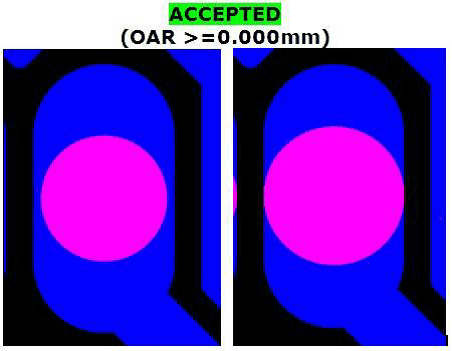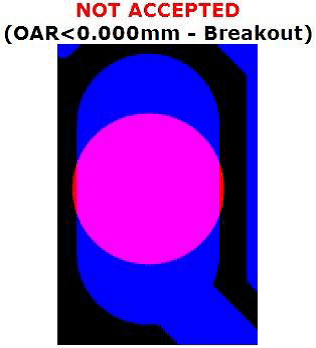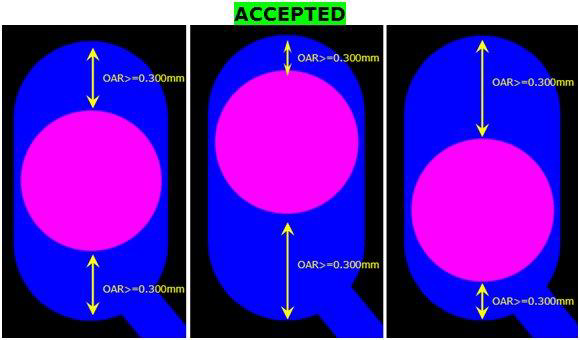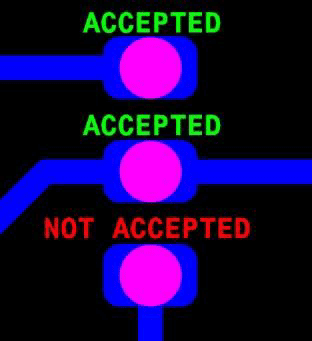Drilled Holes
Introduction
There are 3 types of holes in a PCB, Plated Through Hole (PTH), Non-Plated Through Hole (NPTH) and Via Holes, these should not be confused with Slots or Cut-outs.
Tool List
Tool lists for drill files are ALWAYS read by our CAM system as the finished hole sizes (ENDSIZE).
PCB Drill Tool Sizes
The drill bits used for the manufactured PCB’s are in increments of 0.05 mm.
We will convert the drill sizes in your drill files or tool lists into millimetres and then round them to the nearest 0.05mm.
For example:
- Drill size of 31mil is converted to 0.7874mm and then rounded to 0.80mm.
- Drill size of 33mil is converted to 0.8382mm and then rounded to 0.85mm.
Defining PTH & NPTH Holes
Please provide separate drill files for plated (PTH) and non-plated (NPTH) holes if possible.
If this is not possible it is important to specify different tools for PTH and NPTH holes and mark clearly which are for PTH and which are for NPTH.
When no PTH/NPTH information is supplied we will use the following rules to determine PTH/NPTH:
- For 0-layer and 1-layer boards - ALL holes are considered as NPTH by default.
- For 2-layer and multilayer boards - ALL holes are considered PTH except the following cases which are considered NPTH:
- Non-connected holes without copper pads.
- Non-connected holes where the copper pad size is equal to or smaller than the TOOLSIZE (the copper pad will be removed in single image preparation).
- Connected holes with a copper pad on 1 side (outer), no connection on any other layer (outer or inner) and no copper pad on the other side (outer).
Via Holes
All Via Holes are Plated Through Holes and are defined by default as hole that is <=0.45mm (18mil) in diameter. We allow for Via holes to have a maximum negative tolerance of 0.30mm (12mil) and may be reduced to accommodate a larger annular ring if required. If you need component holes of 0.45 mm or smaller please ensure you specify this in the order details.
IMPORTANT
This default Via Hole rule affects:
- Finished hole size to production drill size (ENDSIZE to TOOLSIZE) conversion.
- The standard tolerance on Via Hole ENDSIZE diameter.
ENDSIZE vs TOOL SIZE Rules
To allow for the plating in the hole we drill holes at a larger size (drill over-sizing).
The conversion rules from finished hole ENDSIZE to production TOOLSIZE are:
Plated Through Holes (PTH)
TOOLSIZE = ENDSIZE + 0.100mm (4mil)
Non-Plated Through Holes (NPTH)
TOOLSIZE = ENDSIZE
Standard Tolerances Holes
These are our standard tolerances that apply to the ENDSIZE of the drilled holes.
ENDSIZE(mm) |
Standard Tolerance(mm) |
||||
|---|---|---|---|---|---|
- |
+ |
Tolerance Range |
|||
| Hole | PTH | ≤4.00 | 0.10 | 0.10 | 0.20 |
| >4.00 | 0.20 | 0.20 | 0.40 | ||
| NPTH | ≤4.00 | 0.05 | 0.05 | 0.10 | |
| >4.00 | 0.10 | 0.10 | 0.20 | ||
When no tolerances are specified in your data, we will produce according to our standard tolerance specifications above.
If you require tighter tolerances please clearly indicated this in the mechanical layer and tool list.
Please note this may increase the cost of the PCB.
VIA Holes
These have a maximum negative tolerance of 0.30mm (12mil).
For definition of VIA holes see the section on Via Holes above.
Drilled Holes Overlapping the Board Contour
Any drilled holes that overlap the board contour will be handled as detailed below.
Plated Through Holes
PTH holes with copper pads will be treated as "plated holes on the board edge" or "Contour Cut PTH drills" and should be clearly indicated in the mechanical layer.
Non-Plated Through Holes (NPTH)
NPTH holes without copper pads will be treated as part of the board outline.
Remarks
Plated holes overlapping the board edge are not available in the PCB proto service.
Overlapping Drilled Holes
Do not overlap drill holes as this may cause drill bits to break and may result in small pieces of material remaining in the hole barrel.
These may then cause voids in the plated hole.
The minimum drill hole to drill hole distance is 0.25mm (10mil), this is measured edge to edge of the drill TOOLSIZE.
Do not use overlapping drill holes to define slots.
See section Mechanical Layer for the correct way to indicate slots and internal cut-outs.
Drilled Holes in Oblong Pads
Drilling holes in oblong pads requires additional rules to ensure the connectivity of the pad is maintained.
The rules for annular rings of oblong pads are NOT different from round pads, but we allow some exceptions to these rules.
Oblong pads with NPTH holes
- MUST ALWAYS FULLY COMPLY with the standard Annular Ring rules for any given pattern class.
- The recommended Annular Ring for any NPTH hole is 0.30mm (12mil).
Oblong pads with PTH holes
The measurements below are taken from the production TOOLSIZE.
- The smallest side of the oblong pad the OAR must be >= 0.00mm (0mil) (i.e. no breakout is allowed) as below:
- On the longest side of the oblong pad in both directions the OAR must be >= 0.300mm (12mil) (but the hole need not be in the centre of the pad) as below:






